How Much Does Content Marketing Cost for Businesses?

Running a blog can be free if you want it to be, but you sacrifice a lot to do it. You have to pay for web hosting, so a free blog limits you to platforms like Medium and WordPress.com. You have to pay for a domain. You have to pay for the best themes and plugins on the market. You hamper yourself a lot if you try to avoid spending a dime.
If you have a budget, though, content marketing can eat it all up. I've known people to run blogs on just a few hundred dollars a year, and I've known companies spending five or six figures per month on their sites. It's all a matter of what money you're willing to spend, and how you're going to spend it.
Where does the cost come from? What can you be spending your money on?
The sky is the limit, so let's take a look at what you might expect in a reasonable scenario.
The DIY Scenario
Small and mid-sized businesses often look for ways to do things themselves, to save money by spending time. It's a perfectly acceptable exchange, particularly if your business doesn't have the budgetary flexibility to spend more. So if you're considering a DIY scenario, here are the various forms your expenses may take, and what sort of price range you might see.
1. Writing is the first major expense. A blog is nothing without the writing, after all, and someone needs to do that writing.
At the cheapest possible end, you can go to a content mill and pay for content on a per-post basis. The cheapest content on these sites is often around $0.05 per word. Higher quality freelancers, on content mills and from other freelancer hubs, can cost you as much as $0.20 per word.

Extremely high-quality freelancers and professional writers can charge more, of course, but these are the kinds of people you tend to contract for a single post, not an ongoing series, or you hire them as an employee with a salary. On a per-project basis, you can find $1 per word or even more, depending on the quality and reputation of the writer
A per-word cost is one thing, but how many words do you need for a blog post? According to my study, the average blog post for 2019 was around 1,250 words. At that length, you can expect to pay between $62 and $250 per post. Experienced writers will cost more, whereas writers who may know English as a second language will cost a lot less, but may also contain more errors or funny-sounding sentences.
Of course, that's if you want your blog posts to be perfectly average in length. I always recommend doing better than the people around you if you want your blog to be a success, so consider something about double that length. A 2,500-word blog post would then run you between $125 and $500, depending on the freelancer you hire.
Now figure that you need to factor in your blogging schedule. I consider anywhere from 1-3 posts per week to be acceptable. One blog post published per week is roughly four posts per month, whereas three posts per week makes 12 blog posts per month. That means at the low end of one post per week from a cheap freelancer, you're looking at around $250 per month at a minimum. A good quality freelancer at three posts per week is closer to $6,000 per month.
2. Editing can be associated with writing, but you may want to have an independent party doing some level of overview. Editing for technical issues, grammar, fact-checking, and checking for plagiarism are all important. You might trust your writer or writers, but you know what they say: trust but verify.
In addition to editing, this involves reviewing each and every hyperlink that you're referencing to ensure they are a high quality site (and nofollowing them were appropriate), adding heading tags, bullet points, bolding, italics, and everything else required in your blogging dashboard. Hey, that's what we're doing right now!
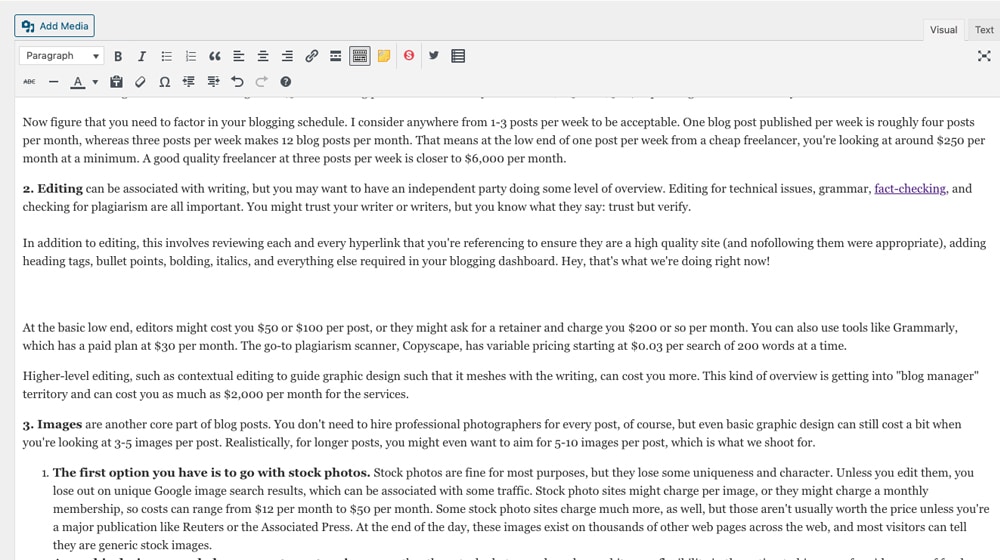
At the basic low end, editors might cost you $50 or $100 per post, or they might ask for a retainer and charge you $200 or so per month. You can also use tools like Grammarly, which has a paid plan at $30 per month. The go-to plagiarism scanner, Copyscape, has variable pricing starting at $0.03 per search of 200 words at a time.
Higher-level editing, such as contextual editing to guide graphic design such that it meshes with the writing, can cost you more. This kind of overview is getting into "blog manager" territory and can cost you as much as $2,000 per month for the services.
3. Images are another core part of blog posts. You don't need to hire professional photographers for every post, of course, but even basic graphic design can still cost a bit when you're looking at 3-5 images per post.
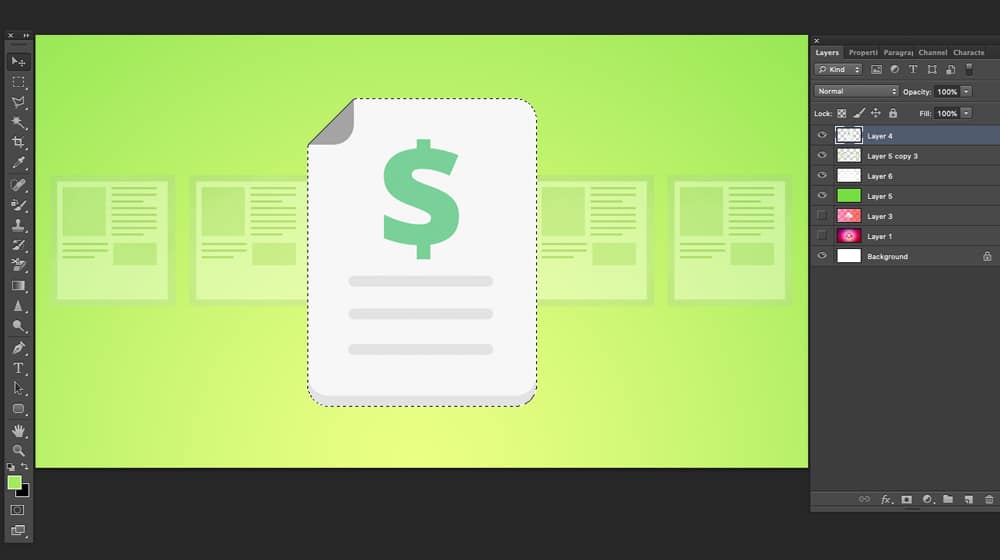
Realistically, for longer posts, you might even want to aim for 5-10 images per post, which is what we shoot for.
- The first option you have is to go with stock photos. Stock photos are fine for most purposes, but they lose some uniqueness and character. Unless you edit them, you lose out on unique Google image search results, which can be associated with some traffic. Stock photo sites might charge per image, or they might charge a monthly membership, so costs can range from $12 per month to $50 per month. Some stock photo sites charge much more, as well, but those aren't usually worth the price unless you're a major publication like Reuters or the Associated Press. At the end of the day, these images exist on thousands of other web pages across the web, and most visitors can tell they are generic stock images.
- A graphic designer can help you create custom images rather than stock photos, and you have a bit more flexibility in the option to hire any of a wide range of freelance designers. Pricing for these varies wider than writers, so you can end up paying anywhere from $200 per month to $1,000 per month, depending on the deal you work out with your designer. These images are made custom in Photoshop and don't exist anywhere else on the web, and may include a watermark of your logo, a custom design or theme across all of your images, or other details that set your images apart. These images are cropped, touched up, and perfected before being uploaded.
4. Site optimization is something you do when you initially design and launch your site, and an overview once every year or two can be a good idea. Keeping up with best practices, auditing plugins and features that don't work, performing site maintenance, optimizing for site speed, and changing your overall site design can all fall under this heading.

Minor audits and optimizations can run you a relatively low price, around $400 for the one-time overview. For a full site design or redesign, or major overhauls, you can be looking at something closer to $2,500. Again, this isn't a monthly cost, but it might be an annual one depending on how much adapting your site needs each go-around.
5. Marketing is another big cost for a blog, and the sky truly is the limit here. Simple marketing, like blog outreach, can be done manually for free. Hiring a personal assistant to do it for you can cost anywhere from $30 to $500 per month depending on where they're located. Tools for outreach can run from $50 to $500 per month depending on their quality and the volume you're using them. The low end is typically fine for SMBs.
Other forms of marketing, like paid advertising on Google or Facebook, can eat up as much money as you throw into them. You can do just fine on $5 a day (or $150 per month) for a low level of awareness and exposure ads, but for the juicy PPC and PPA ads that get you conversions, you're looking at even higher costs. You can, quite literally, spend six figures per month if you have the budget to do so.
6. Analytics round out the core services you'll want to pay for. Google Analytics is free, of course, though you can always hire an analytics firm to review your data and generate meaningful reports for you. I wouldn't recommend it for anything less than enterprise-level data, though.
Beyond that, you might have other analytics tools and data sources you want to use. For example, tracking your site's backlinks through Ahrefs means you need one of their paid plans, which run from $100 to $1,000 per month. There is all manner of other tools you could look for as well, like rank trackers or social monitors, with their associated costs.
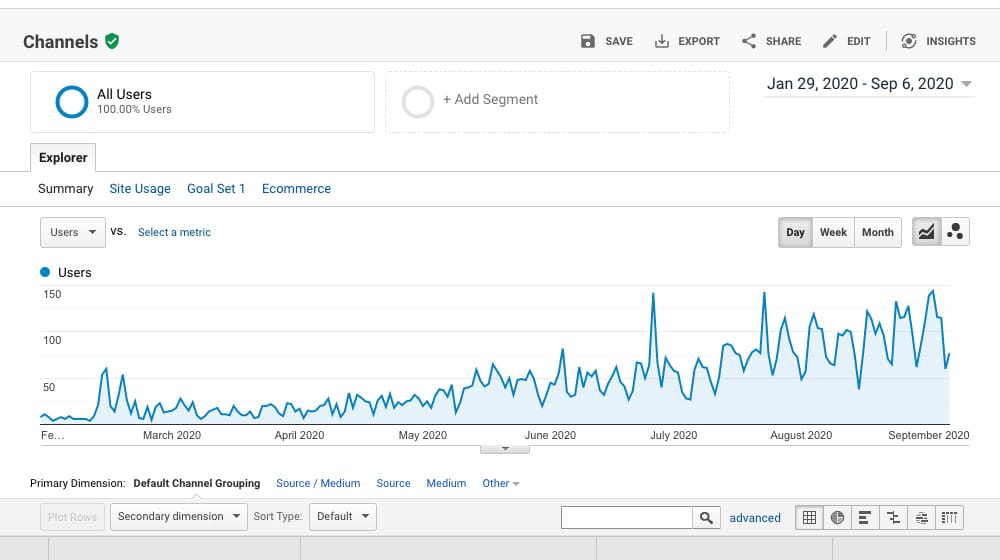
Overall, looking at low and mid-level plans, and putting together a basic idea of what a site might want and find useful, I find that you're going to be spending between $300 and $1,500 per month. Less on the smaller end of sites, more as your site grows and you have more data to track. This is software that most agencies can extend to you, as they already pay for them, but a DIY approach will mean you have to pay for them yourself.
Overall, the costs can vary wildly:
- Small businesses writing one 1,500-word blog post per week, with 2-3 images per post, basic scanning, manual editing, and basic data collection, are looking at a price range of around $2,200 per month minimum.
- Slightly larger businesses who invest a bit more in their blog, with 8x 2,000-word blog posts per month, 3-4 images, and a bit greater overview and more analytics, can be looking at pricing starting around $5,000 per month.
- Mid-size and larger brands who want 12x posts per month, with longer posts around 2,500+ words, more images, and deeper analytics, have correspondingly higher costs. $7,000 per month minimum wouldn't surprise me, and it's what we've seen being offered from many agencies.
All of this can shoot even higher when you have larger teams, people you hire rather than contract as freelancers, or when you dump a budget into marketing. These are baseline, low-end costs when you're willing to spend the money.
Of course, if you're willing to do more of it all yourself, content yourself with lower quality writing, use free alternatives to paid tools, or use risky strategies like group buys, you can save yourself more money, but could potentially experience poor results. It's a balance you need to find.
I will always advocate for quality over quantity; you can always buy more posts as your budget increases, but it's a lot harder to buy more quality for old posts.
The Agency Option
Businesses looking to hire an agency to handle their blogs for them have a lot of options as well. There are hundreds of content marketing companies out there, and there are thousands of more people who offer blog management services at a near-agency level.
Basic agency-style blog management involves hiring individual people or groups to do particular aspects of your blog for you. You have less hands-on responsibilities, but you're not hiring one company to do everything. Companies like The Hoth or FatJoe fall into this category. For example, you might hire 1-3 writers to handle all your writing for you, 1-2 graphic artists to do the images for you, and one blog manager to put all the pieces together, monitor analytics, and handle the rest.

This tends to be the cheaper option but requires more work because you need to manage a group of people. If one of your writers quits or needs to stop for some reason, you need to replace them, whereas if you're hiring a single agency, they handle all of that themselves.
The issue with DIY approaches is there's one of two outcomes; you can either do a better job at a lower cost, or you'll end up doing a worse job at a higher cost. If your content doesn't perform, you may have wasted your money. We see it every day from business owners that we speak to.
Mid-range agencies are agencies that generally handle everything for you. They come up with articles to write, they edit and format them, publish them, and they get results, but they don't necessarily excel. For the price points you find, it's not the worst option, but you can do better if you have the budget for it.
Verblio is one example; their pricing starts is currently $559 per blog post for a 2,000 word post that is done completely for you. This is a little more than our own pricing, so I'd probably include Content Powered in with this group.
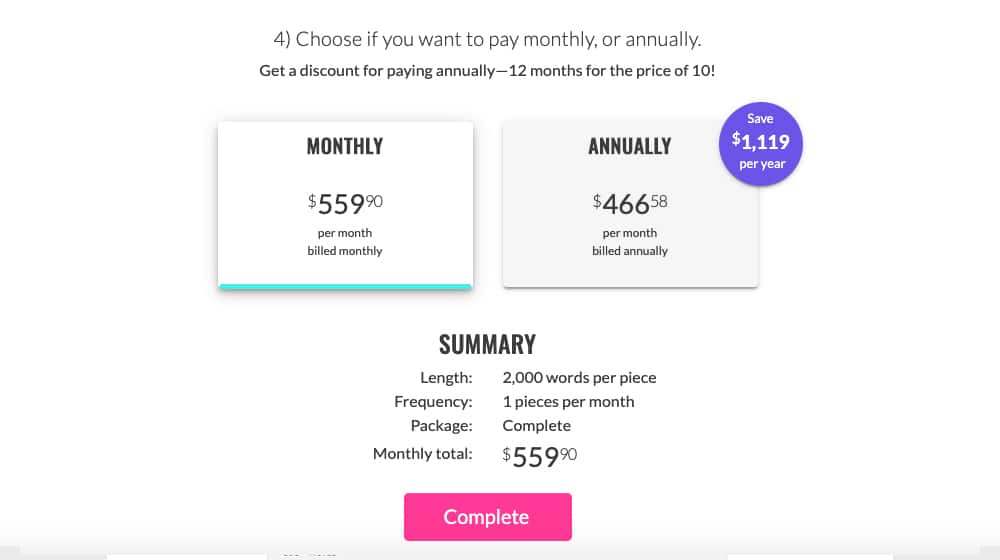
Advanced agency blog management is a "complete" outsourced option. There aren't many of these out there, and it's hard to get a sense of what any of them do without using them. I recommend interviewing several before you make any decision on one and running tests to make sure they're actually providing unique content with high value. There are, unfortunately, a lot of agencies that look good on paper but will happily give you spun content and harmful PBN links to make themselves look good.
Optimist is one example; they have a client minimum of $7,000/mo and are not currently accepting new clients.

Overall, pricing for agency management tends to actually be more contracted than DIY. The low-end management costs more than DIY low-end pricing, but the high-end costs less than equivalent DIY management. Part of this is that agencies can provide you with all the top-end analytics and data by using their own subscriptions to those tools, deferred across all of their customers, so you only pay a fraction for them. Another part is that topic ideation is less of a "fire, ready, aim" approach, and more tactical and picky to only pick topics that will yield results. If a blog post doesn't get any traffic, we consider that post a failure. If all of your posts aren't getting any traffic, then your entire content marketing campaign is a failure.
- A comparable beginner-level site looking for 4x posts per month in the 1,500-word range, with mid-range data reporting and analysis, can be looking at $2,500 per month for an agency doing the work.
- A mid-level site looking for twice the posts, 8x per month at 2,000 words each, with agency-level data reporting and overview, is more likely to see prices around $4,000 per month.
- Higher-level enterprise blogs with 3 posts per week (12 per month) and 2,500 words per post or more, with all the bells and whistles, can see pricing around $6,000 per month.
Of course, everything scales. Want longer content? Want more focus on competitive SEO? Want deeper analytics? Want a special white-glove treatment and a personal concierge for the service? You can get all of that from an agency that offers it, and that can cost you $20,000 per month or more. I'm not kidding when I say that major companies pay five figures or more per month for their blogs.
The True Secret of Pricing
The real secret is that running a blog (whether you're doing it DIY or with an agency) costs exactly as much as you want it to cost.
Everything about a blog can be done for free if you're willing to compromise, either on quality, on the tools you're using, or by spending your time instead of money. You can invest $250 on setting up a site and run everything else yourself, and the only ongoing costs you'd have are a small monthly fee for a domain name and hosting.
Your time, your budget, and your results are the three biggest factors here. Content marketing is almost always over-simplified and requires a number of different skillsets and advanced software. For some, this is a journey that sounds fun and challenging, even if mistakes are made along the way. For others, making mistakes isn't an option, and hiring practiced hands is the solution.
How much do you currently spend on content marketing each month? Do you agree or disagree with any of our thoughts in our article? Please share your experiences with us in the comments below!




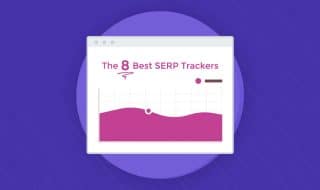





September 20, 2020
I didn’t know that creating and maintaining a blog was this tricky until now. Seems that it could be cheaper if you use a company instead of a DIY approach.
September 21, 2020
Hey Callie!
It certainly can be. With an amateur blogger, you could run into a lot of problems, the biggest being that there isn't a lot of effort being invested in topic research. If a topic has high competition, very little traffic, or attracts the wrong kind of visitors, your blog posts may seem cheaper but they also won't be getting any results. Blog posts that are created by a professional team tend to be more expensive, but a single blog post could end up outperforming dozens of lower-quality posts and helping you recoup those costs with new sales. When you take the revenue and traffic your posts are generating into account, low-quality content ends up being more costly in the long run (despite the lower price tag). It's like buying a high mileage car and having to invest a bunch of money in it later to fix it before it breaks down completely.
Would you rather have 10 comprehensive and higher-dollar articles that bring in new business every month, or 50 cheaper articles that cost less but aren't bringing in any new business?
It's difficult to convey this to some business owners. You see the sunk-cost-fallacy every day; people that have thousands of cheap articles that they don't want to delete, even if they have duplicate/plagiarized content and those articles aren't getting any traffic at all.
Don't cheap out on your content folks - it's designed to exist on the internet for a very long time. Make sure you're actually reading your content, checking to make sure they taught you something, checking grammar, checking duplicate content, citing high authority sources, and everything else that your writer and marketing team should be checking for you. Creating legitimately good content is a lot of work.
If you are just posting low-quality outsourced articles and hoping for the best, I definitely recommend hiring a pro to see what you're doing and help you correct your course.
March 15, 2021
They say that it's best to do DIY as it is cheaper, na-ah! I ended up spending a ton of money on crappy content that didn't get any traffic. Big waste of time and money.
March 15, 2021
Hey Jennie!
I agree, a DIY approach is usually cheaper and can still be effective, but it can also become a disaster if it's not executed properly.
The challenge with content marketing is it's one half "content" and the other half is "marketing".
Most people simply hire a writer to write an article and upload it, but no marketing was done for the post. Keyword research, competitive research, intelligent topic ideation, graphic design, on-page SEO, etc.
If your topic is a poor choice from the start, then even the most talented writer won't make much of a difference in how it performs.
This is why most content teams have at least 4 people; someone to upload it and optimize the article, someone to write it, someone to perform the research and find winning topics, and a graphic designer.
You might be able to find someone who can do it all, but it's difficult to find someone who is reliably creative and analytical like this.
If you want me to take a look at what you have, drop me an email! I'd be happy to help.